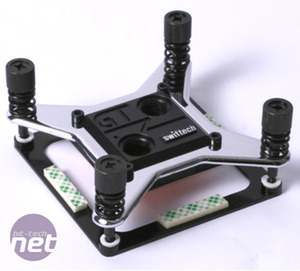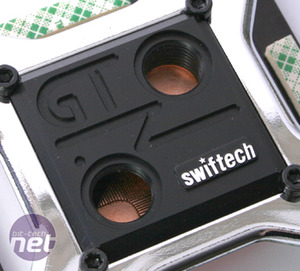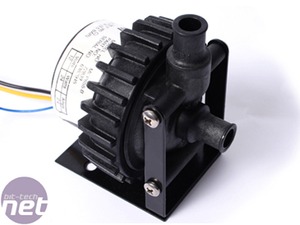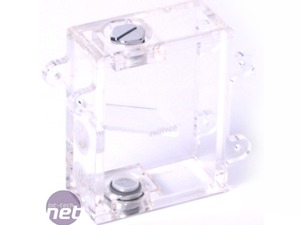
CPU waterblock: Swiftech Apogee GTZ
The Apogee GTZ is the heart and soul of the Apex Ultima. Unlike earlier Swiftech CPU waterblocks, such as the Apogee GTX which comprised a mixture of copper and aluminium, the Apogee GTZ comprises a mixture of copper and black plastic. This means even if you forget to add a corrossion inhibitor to the coolant, the inside of the waterblock won't suffer from galvanic corrosion.As standard the Apogee GTZ is pre-fitted with a LGA1366 mounting kit for Core i7 motherboards, but there is also a LGA775 mount included in the box. Socket AM2+/AM3, LGA771 and Socket F mounts are available separately for free if you contact Swiftech via its website. The contact plate inside the waterblock is machined from solid copper and is topped by a combination of grooves and pins. The grooves are located on the outer edges of the contact plate, while the centre, where the CPU will actually make contact is covered by hundreds of tiny pins. This helps to increase the surface area of the contact plate, aiding the conduction of heat from the plate into the coolant flowing over it.
Unlike some waterblocks the Apogee GTZ has a specific inlet and outlet so you need to make sure you plumb it in correctly. The manual explains how do to this, but to help matters the plastic top of the waterblock has also been drilled with a small indentation next to the inlet. The barbs are widely spaced apart, so you won't experience any issues securing the tubing unlike the troublesome D-TEK FuZion.
The Apogee GTZ is also incredibly easy to fix to an LGA1366 motherboard - it is secured by four spring loaded screws that pass through the motherboard into a backplate on the underside of the PCB. This in direct contrast to many other CPU waterblocks, that fix to the motherboard via a complex and easy to get wrong combination of springs, nuts and bolts. Swiftech supplies a small syringe of Arctic Ceramique TIM to spread between the underside of the Apogee GTZ and CPU heatspreader.
Pump: Swiftech MCP655-B
The MCP655-B pump is one of the few components included in the Apex Ultima that Swiftech doesn't manufacture itself. Instead, as any water-cooling afficianado should have already spotted, the MCP655-B is actually a re-badged Laing D5. That isn't a bad thing though - the D5 is one of the most powerful and reliable pumps and as a result has been in production for years.The only downside is its large size - it's much harder to find a place inside a small case than the equally popular, but much more compact, Laing DDC. The '-B' at the end of its name denotes that this is fixed-speed version of the D5, so its output pressure output is fixed at 350 PSI and its input voltage at 12V.
Reservoir: Swiftech MCRES-Micro Rev 2
Like many of the components included in the Apex Ultima the reservoir is a slightly improved version of a previous Swiftech product, the MCRES-Micro. The Rev 2 is very similar to the original model, so it's still made from transparent plastic and is designed to sit vertically inside your PC's case. This makes it easier and safer to fill than a bay reservoir, although it can be a struggle to find a place for it inside small cases. Although you can screw the MCRES-Micro Rev 2 onto a metal plate which in turn is screwed down onto the case, you can avoid drilling a hole in your case by looping cable ties through the four rings on the right hand edge and the air vent found in most cases above the expansion slots.The Rev 2's improvements over older models include changing the screwthreads from PG7 standard to 1/4in BSPP, making it compatible with a wider range of non-Swiftech supplied barbs. Swiftech has also added an additional port in the floor of the Rev 2 reservoir. This not only fixes one of the main shortcomings of the original MCRES-Micro (it was hard to drain), but also adds the possibility of using a second pump. However, as supplied with the Apex Ultima you only need to use a single inlet and outlet.
To encourage air to become trapped inside the reservoir, instead of circulating through the loop, the upper port should be used as the inlet from the CPU waterblock and the lower port as the outlet to the pump. Even so the MCRES-Micro Rev 2 takes considerably longer than most reservoirs to fully bleed the loop of excess air - we had to keep our test system running for close to 30 minutes before it finally got rid of most of the bubbles.

MSI MPG Velox 100R Chassis Review
October 14 2021 | 15:04












Want to comment? Please log in.